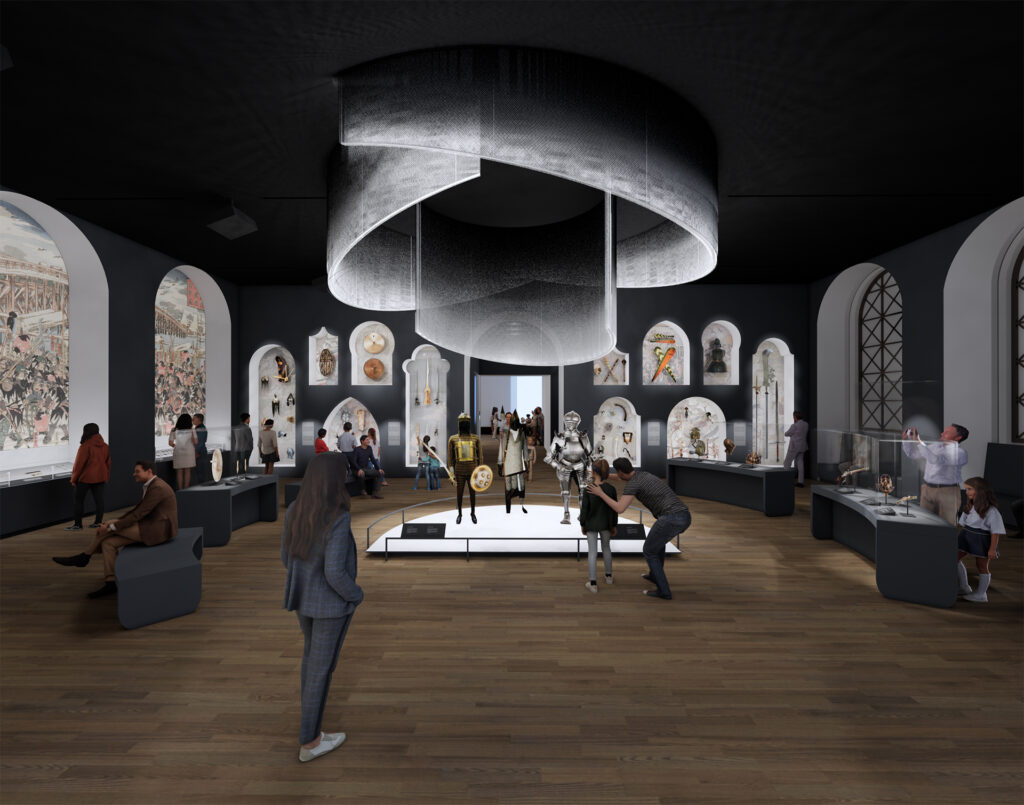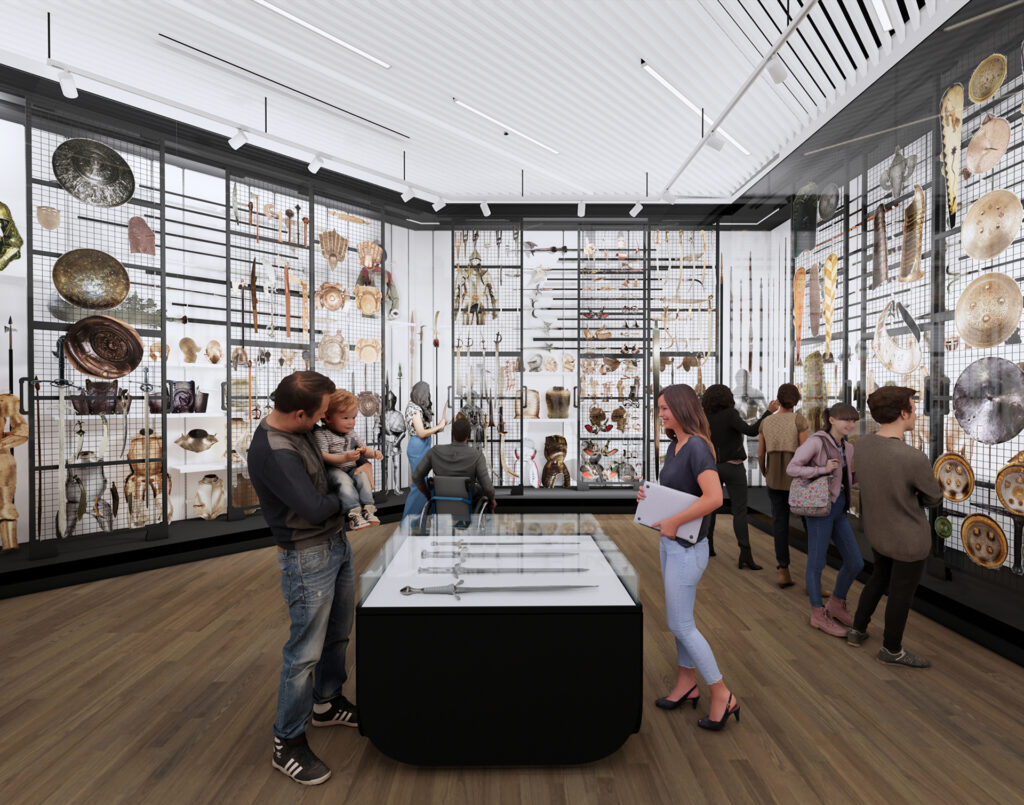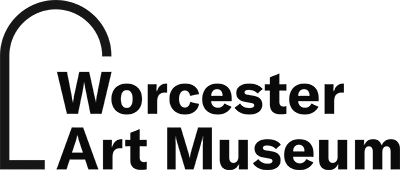Approximately $6 million project is the culmination of a multi-year initiative to present and preserve this
important collection in its home city of Worcester


Concept design renderings for the Worcester Art Museum’s forthcoming Arms and Armor Galleries. Courtesy TSKP x IKD.
Worcester, MA—April 22, 2024—The Worcester Art Museum (WAM) today shared updated plans—and the new renderings—for its new Arms and Armor Galleries, which are currently under construction and will open in late 2025. Presenting the Museum’s collection of arms and armor, the second largest of its kind in the Americas, these galleries will span approximately 5,000 square feet. Where the old installation at the Higgins only allowed for a small part of the collection to be on view, new installations and an innovative open storage system will allow for almost the entire collection to be on view. In all, more than 1,000 objects—from medieval and Renaissance Europe alongside pieces from ancient Greece, Egypt, Japan, India, and beyond—will showcase the remarkable global and historical breadth of the collection, which includes at its core the Museum’s Higgins Armory Collection. In keeping with the Museum’s other arms and armor installations, the new galleries will also integrate non-arms artworks that will enhance the narratives and connections across cultures and periods.
Centrally located on the Museum’s second floor, the new Arms and Armor Galleries will occupy what was previously WAM’s library space, a generous space with 16-foot-high ceilings and arched windows, and an adjacent area that had served for temporary exhibitions. Upon entering the front gallery, audiences will engage with dramatic arms and armor displays with star objects from the collection. The rear gallery will provide the look and feel of open storage, giving visitors a behind-the-scenes glimpse of what museums do to preserve and share these objects, and will offer spaces for hands-on programming and demonstrations.
The Arms and Armor Galleries were designed by TSKP x IKD, in collaboration with Jeffrey L. Forgeng, the Higgins Curator of Arms and Armor and Medieval Art at WAM, and Museum leadership, with significant contributions from scholars, educators, and organizational partners. The Museum’s library—an important resource for art history research in Central Massachusetts—reopened in early 2022 in a newly created 3,400-square-foot two-level space in the Museum’s Higgins Education Wing, thus creating the opportunity for these new galleries. On June 16, the Museum will host a public talk with Forgeng, who will offer a first glimpse at the new galleries through renderings, photos, and behind-the-scenes stories. Learn more at www.worcesterart.org/events.
“This is a major milestone in the development of our new Arms and Armor Galleries, and on behalf of the Museum’s whole team, I am excited to be able to share these design plans with our public,” said Matthias Waschek, the Museum’s Jean and Myles McDonough Director. “These objects offer an exceptional window into the artistry, culture, and technology behind arms and armor, and our presentation will place these artifacts in a context that resonates with contemporary issues and underscores our role as a place of learning, inspiration, and profound reflection. I want to thank our many donors who allowed us to undertake the most significant reshaping of the Worcester Art Museum’s galleries and collections in decades, and part of our commitment to ensure that this important collection remains in our city.”
Among the objects that will be on view are:
- Helmet in the Form of a Sea Conch Shell (Japan, 1618): A remarkable piece likely worn by one of Japan’s leading figures during the era of Tokugawa Ieyasu, admired for its unique design and exquisite craftsmanship.
- Gladiator Helmet (Roman Empire, c. 1st Century C.E.): Among only three such artifacts in the Americas, this helmet offers a rare glimpse into the dramatic world of Roman colosseum sports.
- Prototype Experimental Helmet Model 2 (United States, 1917): A testament to the revival of armor design in the 20th century, this helmet is a product of a collaboration between John Woodman Higgins and Met curator Dr. Bashford Dean that set Higgins on the path to collecting historical armor.
- Pair of Gauntlets for Prince Philip of Spain (Augsburg, 1549–50): Part of the “Flowers Garniture,” these gauntlets represent the apex of Renaissance armor craftsmanship, made by one of Europe’s most skilled armorers, decorated by one of the leading armor etchers and worn by one of the most important historical figures of the period.
- Bow-case Cover (Ottoman or Mamluk, 1600s): Reflecting the nomadic heritage of the Turkish peoples, this piece combines luxury with traditional design, illustrating the intersection of culture and utility.
- Helmet (Africa, Sudanic Region, 1800s): Worn by a high-ranking warrior, this helmet showcases the influence of Islamic armor design, distinguished by its exceptional quality and original gold-covered surface.
- Mahi Maratib or Fish Standard (Central India, early 1700s): This striking figure in the shape of a monstrous fish was formerly fitted with a long sleeve of silk that would flutter and snap in the wind as it was carried above the heads of an army during the age of the Mughal Empire.
A major component of the Museum’s installation plan is to rethink traditional ideas for accessibility, both physical and intellectual, in ways that support WAM’s strategic priority of increasing access, equity, inclusivity, and diversity at the Museum. That includes deploying a range of interpretive modes—some of which the Museum has been piloting in its renovated Medieval Galleries over the last several years—to support and engage audiences with an array of interests, learning styles, and abilities.
Among these are: hands-on, tactile interactives, giving visitors an opportunity to address their curiosity about, for example, the weight and feel of armor; new digital tools that will provide in-depth information on objects in the galleries’ open storage; “static interactives,” such as wall maps highlighting key locations for armor production or use; and new approaches to in-gallery seating that provides a relaxing place from which to study the objects. WAM will also continue its unique, ongoing program of live interpretation around its arms and armor collection, including costumed presentations that feature knights and samurai—opportunities to learn about the arms and cultures from around the world.
“I’m thrilled to be able at last to share our design for the future arms and armor gallery,” said Jeffrey L. Forgeng, The Higgins Curator of Arms and Armor and Medieval Art at WAM. “Our team has been working for a decade to create a plan that will do justice to the amazing objects in the Higgins Armory Collection. The new galleries will tell a global story that explores the mythic power of these objects in the various cultures that used them, a power that still resonates for visitors whenever they see a suit of armor. Through this custom-designed space, we are looking forward to offering a powerful experience that will encourage our audiences to indulge their natural curiosity about these objects and feel themselves as part of the Museum.”
The Museum’s new Arms and Armor Galleries is an approximately $6 million capital project—for which WAM has raised $5.5 million to date from public and private funders, including multiple awards from the Institute of Museum and Library Services and National Endowment for the Humanities, underscoring the national importance of this collection and innovation of the Museum’s presentation. A full list of project funders, consultants, and partners is available at www.worcesterart.org/about/campus-transformation/arms-and-armor-gallery/. WAM had previously raised an additional $2 million to endow its Curator of Arms and Armor position ensuring the long-term success of this role in working with this key collection. This project is part of the Museum’s ongoing fundraising campaign, A Bold Step Forward, which seeks to raise $125 million by 2028 to improve and modernize Worcester Art Museum facilities, strengthen programming and operations, grow the endowment to ensure long-term financial strength, and allow the Museum to connect with new audiences and broaden the narratives told through art. The Museum is more than halfway towards this goal. To learn more, visit www.worcesterart.org/join-give/bold-step-forward.
About the Worcester Art Museum
The Worcester Art Museum creates transformative programs and exhibitions, drawing on its exceptional collection of art. Dating from 3000 BCE to the present, these works provide the foundation for a focus on audience engagement, connecting visitors of all ages and abilities with inspiring art and demonstrating its enduring relevance to daily life. Creative initiatives—including pioneering collaborative programs with local schools, fresh approaches to exhibition design and in-gallery teaching, and a long history of studio class instruction—offer opportunities for diverse audiences to experience art and learn both from and with artists.
The Worcester Art Museum, located at 55 Salisbury Street in Worcester, MA, is open Wednesday through Sunday from 10 am to 4 pm. For information on admission and discounts, visit https://www.worcesterart.org/visit. Museum parking is free.
For more information, please contact:
Madeline Feller
Worcester Art Museum
MadelineFeller@worcesterart.org
508-793-4373
Sascha Freudenheim
PAVE Communications & Consulting
sascha@paveconsult.com
917-544-6057

